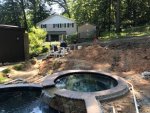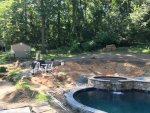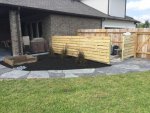Looks very nice!
Take lots of pics from varying angles and include a tape measure or yard stick to locate your pipes. If you decide to build or dig around the pad, you will want to be certain you don't do any damage.
I chose the cedar fencing because my pad was built on sloped and uneven ground. Using perpendicular planks allows you to follow the slope of the ground. All the siding was screwed so it can be removed for servicing equipment and replaced if it rots. The pressure treated framing should last for many years. Use only hardware compatible with pressure treated wood.
I had some height limitations on my structure (an apple tree) so it only sits about 6" above the top of the filter. I made the portion of the roof above the filter lift-able so I could remove the filter cover for cleaning. A couple of wood supports rotate up to keep the roof elevated during servicing. I vented the heater out the back of the structure.
Someone questioned airflow within the enclosure. My only concern is when I run the heater, which is pretty rare. The siding allows airflow between the planks and there is some space between the ground on the bottom edge of the planks. I usually leave a door open while heating or I can raise the roof if really needed. I've run the heater with the doors fully closed and have experienced no fault codes.
I have some above average DIY skills so I just took it one step at a time. I added some shelving in a dead area of the enclosure for floats, hoses, toys, and supplies. At the risk of my work being critically assessed, I'll attach some additional pics for reference.






















